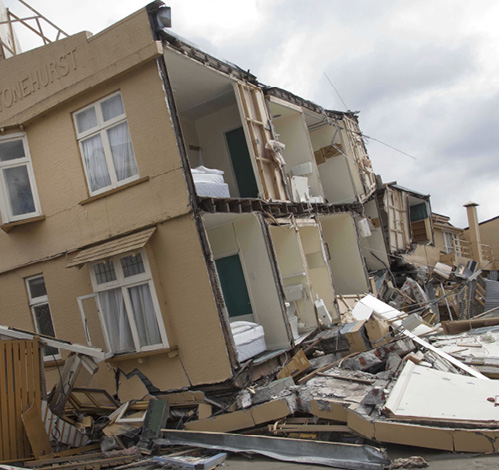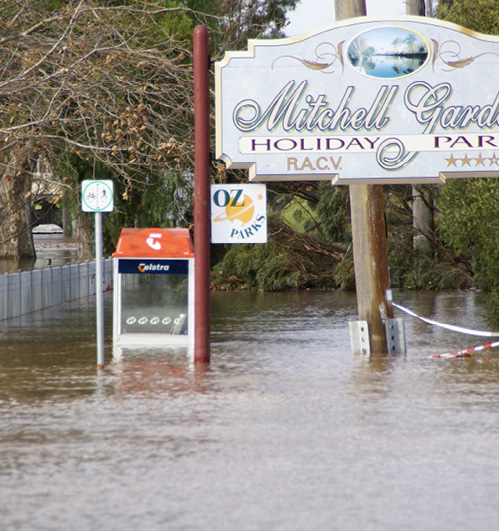
By Nathan Maddock, Senior Communications Officer, Bushfire and Natural Hazards CRC
With the cost of natural hazards forecast to rise dramatically over the next 30 years, mitigation of these hazards has never been more important, especially once the fact that every dollar spent on mitigation can save four dollars in recovery costs is factored in. In an effort to counter this, Bushfire and Natural Hazards CRC research is providing quantifiable evidence that will support mitigation options for a range of natural hazards, reducing the amount of money that government spends on emergency response and recovery.
It is all about strategic investment now to reduce future costs, says Professor Holger Maier, who is leading the CRC project to develop an integrated modelling tool to support strategic decisions.
‘Everyone wants to talk about mitigation and risk reduction. But we need to put a value on these things, so that we have an evidence base that enables decisions to be justified on a rational basis with the best available information,’ said Professor Maier.

Although as it currently stands, decision-makers do not have this vital information.
‘There is nothing that allows for comparison of different hazards and their mitigation options, and to also look at long-term planning,’ said Professor Maier.
To address this gap in Australia’s emergency management preparations, the tool has been in development for the last three years by a truly international team. The team consists of CRC researchers from the University of Adelaide (Professor Maier, Graeme Riddell, Jeffrey Newman, Dr Aaron Zecchin, Emeritus Professor Graeme Dandy and Charles Newland) and the Research Institute for Knowledge Systems in the Netherlands (Associate Professor Hedwig van Delden and Roel Vanhout) leading the collaboration, with expert assistance from Dr James Daniell and Andreas Schäfer from the Karlsruhe Institute of Technology in Germany.
The team has been developing a generic approach to assessing the long-term impacts of different mitigation options on different hazards. This approach is then applied to a series of case studies to investigate the effectiveness of policy and planning investment options for optimal mitigation of natural hazards. The case studies comprise three separate locations; Adelaide, Melbourne and Tasmania, with each location looking at a range of hazards and their mitigation options over time. This allows emergency managers to assess the dollar costs of the impacts of mitigation decisions.
‘The idea is that people can start looking at the impacts of long-term changes—things like climate change, economic conditions, and population and the impact these have on the different risks associated with different hazards.
‘We can also look at different mitigation options and risk reduction strategies so we can assess different combinations of risk reduction measures, such as changing building codes, building flood levees, land use planning or community education.
‘It provides a holistic framework for looking at different hazards and mitigation strategies,’ explained Professor Maier.

Evidence holds the keys to change, and to gather this evidence, the team’s case studies, in addition to focusing on different locations, are assessing different combinations of hazards, with different emphases, all under the direction of end-user partners.
The Adelaide case study is assessing earthquake, bushfire, coastal inundation, flooding and heatwave. The Melbourne case study is looking at bushfire, flood and potential earthquake. Tasmania’s study is investigating bushfire and flood. For each case study, the tool will analyse areas of risk both now and into the future, test different types of risk reduction options, identify mitigation portfolios that provide the best outcomes for a given budget, and consider single or multiple types of risk reduction options. End-user partners emphasise the importance of understanding where various societal groups are likely to live in the future, as well as their vulnerability to risks in these areas.
With natural disasters currently costing Australia in excess of $9 billion annually, a figure projected to skyrocket to $35 billion by 2050, facts around economic effectiveness of mitigation options will be incredibly valuable to high-level strategic decision-makers within emergency and land management agencies, as well as treasury and premier and cabinet government departments, as they look to reduce the costs associated with natural disasters.
This has bred an appetite for this type of assessment of mitigation decisions in emergency and land management in Australia.
‘At the moment a lot of the focus has been on responding to hazards, but because there is such a large projected cost associated with natural hazards, there has been a realisation that we need to start looking at longer-term strategic planning.
‘There is also the realisation that climate change is going to have an effect and that our population is ageing and becoming more vulnerable. So the key question really is: how do we prepare for that?
‘It really is a complicated problem, when we are looking at how the different hazards interact with each other, and with a given budget, it is difficult to know how emergency agencies can get the best bang for their buck. The tool will help agencies assess what the best strategies are, to get the best outcomes for a given amount of money spent,’ Professor Maier said.
The greater Adelaide case study is currently the most progressed, with a working prototype nearly ready to hand over to end-users. For greater Melbourne and Tasmania, end-users in these states have worked with the research team to assess how they would use the system, and what its functionally should be, with the team currently working on data collection for these areas.

The learnings and outcomes so far, especially from the Adelaide case study, are varied, Professor Maier explained. There are learnings about the actual system and how the modelling behind it works, but there are also outcomes for end-users.
‘Some of the scenarios we have developed in consultation with end-users, which represent different plausible futures, have resulted in quite different outcomes in terms of where people would live (in the future) and what the risks would be for different hazards.
‘This indicates that the planning you need to do to cater for these plausible futures would be quite different,’ said Professor Maier.
End-user Ed Pikusa, Principal Flood Management Officer at South Australia’s Department of Environment, Water and Natural Resources, believes the research will lead to better decisions in emergency management right around Australia.
‘All emergency management practitioners and land managers across the country need to make informed choices to reduce losses from natural disasters.
‘We ask questions like “what are the benefits and costs of mitigation options?”, “how do we quantify many of the intangibles?” and “who owns the risk?”’
‘In a multi-stakeholder environment it can be complicated, and it is hoped tools like those being developed by this project will help agencies answer these important questions,’ Mr Pikusa said.
While helping emergency services answer the difficult question of where to invest money in order to achieve the largest reduction of risk—the main aim of the research—it cannot be underestimated how valuable the process has been in other contexts.
‘The outputs from the tool are one thing, but it is also about providing people with an environment that enables them to think more strategically, and for agencies to start working together and imagining what could happen in the future. This has been a really positive experience.
‘In the future, it is hoped that the tool will be able to be rolled out to other states and cities. The idea is to make the approach as generic as possible.
‘All going well, we would like to develop case studies looking at different types of applications for end-users, such as local councils, single-hazard agencies and agencies responsible for high-level planning such as state treasury or premier and cabinet departments; agencies that are making high-level strategic decisions.
‘The tool is flexible enough to be applied in a lot of different contexts. It allows users to answer the question ‘is this something we should be doing?’,’ Professor Maier said.
The project is a vital part of the CRC’s research program, as it uses the outputs of many other studies. CRC Research Manager Dr Michael Rumsewicz believes it has the potential to be a game changer in how Australia builds resilience to natural disasters.
‘It has been exciting watching this project develop, and getting an appreciation for both the power of the approach and how it brings many apparently disparate pieces of information together.
‘It already draws together information from about a half a dozen other CRC projects, and has the potential to link to even more across our broader research programs in economics, risk, social resilience, volunteering, engineering, information management, prescribed burning and coastal management.
‘More generally, though, as I have gone around the country talking to people about the major issues facing Australia regarding natural hazards, a recurring theme has been ‘we do not know how to quantify the benefit of mitigation spending’.
This project, with its focus on being end-user driven, and how it brings together research from a variety of sources, provides the evidence base needed to support long-term political and operational decision-making.
‘This is a world-leading piece of research enabled by the contributions of end-users and researchers working together as a united team for a common goal,’ said Dr Rumsewicz.
Find out more about this research at bnhcrc.com.au.